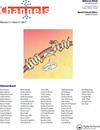超极化激活环核苷酸门控(HCN)通道研究的文献计量学分析(2004-2020)
IF 3.2
3区 生物学
Q2 BIOCHEMISTRY & MOLECULAR BIOLOGY
引用次数: 0
摘要
HCN通道家族包括四个成员(HCN1-4),在心脏和神经系统中表达。HCN通道产生的电流称为I-h(或I-q的i)。I-h也被指定为起搏器电流,因为它在控制心脏起搏器细胞的节律性活动和自发放电神经元中起关键作用[1]。HCN通道功能的多样性部分归因于其亚细胞定位的差异[2]。HCN通道是高度调控的蛋白,对不同的细胞刺激作出反应,它们在超极化电位下打开,携带混合Na/K电流,并受环核苷酸调节[3]。这些通道在调节细胞兴奋性、节律性活动、树突整合和突触传递中发挥重要作用。HCN通道的功能包括设置静息电位、突触归一化、增益控制、后超极化、设置树突反应、介导大麻素在神经元可塑性中的作用以及可塑性门控等[4]。这些功能与多种疾病有关,包括重度抑郁症、神经性疼痛和多种癫痫亚型[4,5]。在已知的四种亚型中,HCN1在新皮层和海马中表达最多。有研究认为,HCN1蛋白表达和表面表达的协同变化是内源性HCN1蛋白在皮质神经元中功能调控的关键机制[6]。HCN1可能参与迷走神经调节减少,并可能导致精神分裂症患者心脏死亡率增加[7]。HCN2离子通道活性在周围神经性疼痛(PNP)的进展中起着至关重要的作用。一些研究表明,HCN2通过激活NMDA受体介导的CaMKII信号通路诱导脊髓LTP,从而促进神经性疼痛的发生,HCN2通道表达的减少通过抑制促炎反应和NF-kappa B的激活来减轻神经性疼痛[8,9],与所有其他hcn3一样,细胞外镉对hHCN3的抑制是快速可逆的,而细胞外应用ZD7288对hHCN3的抑制是缓慢不可逆的。人类通道不受细胞内cAMP调节,这是其他已知HCN通道的标志,因此对cAMP的缺失反应将人类HCN3与cAMP反应良好的HCN亚型2和4以及弱反应亚型1区分开来[10]。IGL神经元中HCN3通道的上调对于内在兴奋性和节律性突发放电至关重要,PIP2通过对HCN3通道门控的影响,作为i -h依赖性特性的强大调节剂[11]。HCN4在与情绪和焦虑障碍相关的大脑区域表达,包括特定的丘脑核、基底外侧杏仁核和中脑多巴胺系统[12]。本文章由计算机程序翻译,如有差异,请以英文原文为准。
Bibliometric analysis of hyperpolarization-activated cyclic nucleotide-gated (HCN)channels research (2004-2020)
The HCN channel family comprises of four members (HCN1-4) expressed in the heart and nervous system. The current produced by HCN channels is known as I-h (or I-f or I-q). I-h has also been designated as pacemaker current because it plays a key role in controlling rhythmic activity of cardiac pacemaker cells and spontaneously firing neurons [1]. The diversity of functions that HCN channels perform is partly attributable to differences in their subcellular localization [2]. HCN channels are highly regulated proteins, which respond to different cellular stimuli, they open at hyperpolarizingpotential, carrymixed Na/K current, and are regulated by cyclic nucleotides [3]. These channels play important roles in modulating cellular excitability, rhythmic activity, dendritic integration, and synaptic transmission. HCN channel functions range from setting resting potential, synaptic normalization, gain control, after-hyperpolarization, setting responses in dendrites, mediating cannabinoid role in neuronal plasticity, to the gating of plasticity [4]. These functions have been implicated in a wide range of diseases, including major depressive disorder, neuropathic pain, and multiple subtypes of epilepsy [4,5. Among the four known isoforms, HCN1 is the most expressed in the neocortex and hippocampus. Some studies suggest that coordinated changes in protein expression and surface expression of HCN1 serve as the key regulatory mechanisms controlling the function of the endogenous HCN1 protein in cortical neurons [6]. HCN1 might be involved in reduced vagal modulation and possibly in increased cardiac mortality in schizophrenia patients [7]. HCN2 ion channel activity plays a crucial role in the progress of peripheral neuropathic pain (PNP). Some studies suggest that HCN2 contributes to the development of neuropathic pain by inducing spinal LTP via activation of NMDA receptor-mediated CaMKII signaling, decreased HCN2 channel expression attenuates neuropathic pain by inhibiting pro-inflammatory reactions and NF-kappa B activation[8,9] Like all other HCNs, hHCN3 was inhibited rapidly and reversibly by extracellular cesium and slowly and irreversibly by extracellular applied ZD7288. The human channel was not modulated by intracellular cAMP, a hallmark of the other known HCN channels so the missing response to cAMP distinguishes human HCN3 from both the well cAMP responding HCN subtypes 2 and 4 and the weak responding subtype 1[10]. Upregulation of HCN3 channels in IGL neurons is essential for intrinsic excitability and rhythmic burst firing, and PIP2 serves as a powerful modulator of I-h-dependent properties via an effect on HCN3 channel gating[11]. HCN4 is expressed in brain regions relevant to mood and anxiety disorders including specific thalamic nuclei, the basolateral amygdala, and the midbrain dopamine system[12].
求助全文
通过发布文献求助,成功后即可免费获取论文全文。
去求助
来源期刊

Channels
生物-生化与分子生物学
CiteScore
5.90
自引率
0.00%
发文量
21
审稿时长
6-12 weeks
期刊介绍:
Channels is an open access journal for all aspects of ion channel research. The journal publishes high quality papers that shed new light on ion channel and ion transporter/exchanger function, structure, biophysics, pharmacology, and regulation in health and disease.
Channels welcomes interdisciplinary approaches that address ion channel physiology in areas such as neuroscience, cardiovascular sciences, cancer research, endocrinology, and gastroenterology. Our aim is to foster communication among the ion channel and transporter communities and facilitate the advancement of the field.
 求助内容:
求助内容: 应助结果提醒方式:
应助结果提醒方式:


